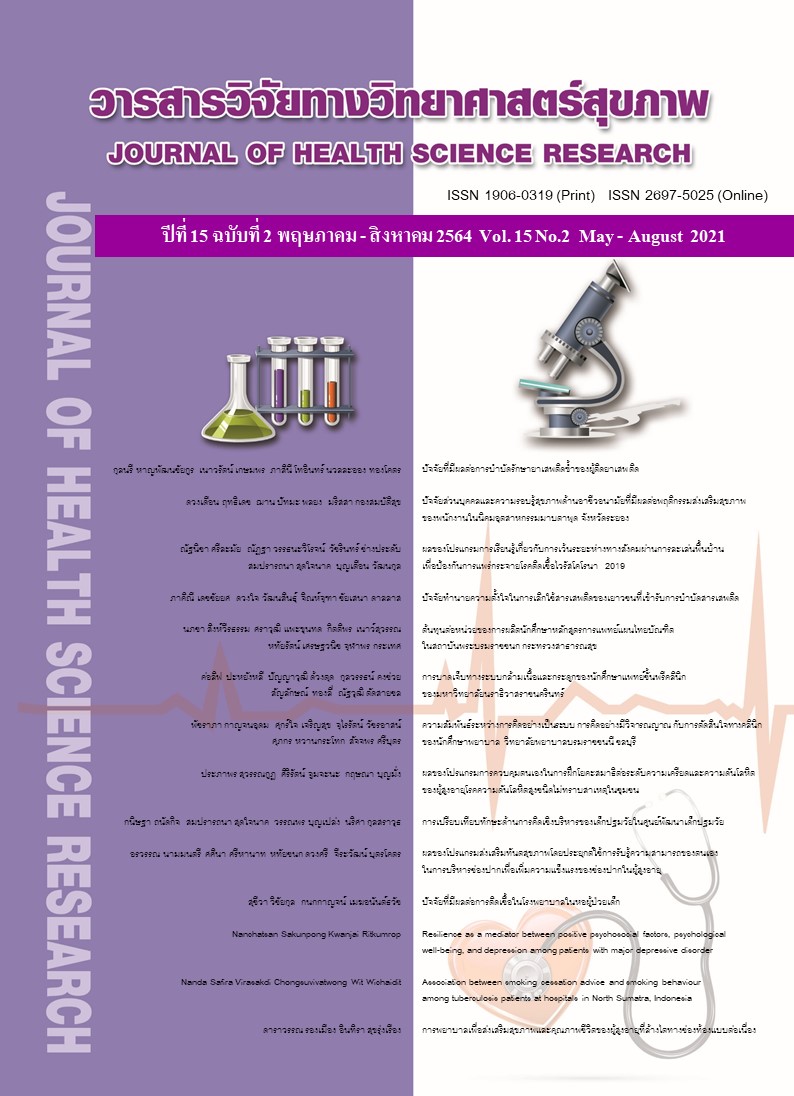ปัจจัยที่มีผลต่อการติดเชื้อในโรงพยาบาลในหอผู้ป่วยเด็ก
Main Article Content
บทคัดย่อ
บทนำ : การติดเชื้อในโรงพยาบาล คือ การติดเชื้อที่เกิดขึ้นภายหลังจากที่ผู้ป่วยได้รับการรักษาในโรงพยาบาลเกิน 48-72 ชั่วโมง มีอุบัติการณ์การเกิด ร้อยละ 4.00 – 5.00 ทั่วโลก
วัตถุประสงค์การวิจัย : เพื่อศึกษาปัจจัยที่มีผลต่อการติดเชื้อในโรงพยาบาลในหอผู้ป่วยเด็กที่มีอายุตั้งแต่แรกเกิด ถึง 15 ปี
วิธีการวิจัย : ศึกษาจากการทบทวนวรรณกรรมอย่างเป็นระบบจากฐานข้อมูลออนไลน์ ตั้งแต่ปี พ.ศ. 2554-2564 มีผลการศึกษาวิจัยที่เข้าเกณฑ์ทั้งหมด 328 เรื่อง ตัดความซ้ำซ้อน วิเคราะห์เนื้อหา สังเคราะห์ข้อมูลโดยการแยกประเภท ได้การศึกษาที่สอดคล้องกับปัจจัยที่ทำให้เกิดการติดเชื้อในโรงพยาบาล 18 เรื่อง เป็นการศึกษาเชิงปริมาณ 17 เรื่อง และการศึกษาเชิงคุณภาพจำนวน 1 เรื่อง
ผลการวิจัย : พบปัจจัยที่ทำให้เกิดการติดเชื้อในโรงพยาบาล 14 ปัจจัยย่อยจาก 2 ปัจจัยใหญ่ ดังนี้ ปัจจัยภายใน ได้แก่ 1) ทัศนคติ 2) วัฒนธรรมความเชื่อส่วนบุคคล 3) ความตระหนักรู้ของบุคลากร
4) ความรู้และการศึกษาอบรม 5) ทักษะการทำงาน 6) ประสบการณ์การทำงาน และ 7) การความรู้และการรับรู้ของผู้ดูแลเด็ก ปัจจัยภายนอก ได้แก่ 1) นโยบาย 2) แนวปฏิบัติของโรงพยาบาล 3) สิ่งสนับสนุนด้านทรัพยากรและงบประมาณ 4) ฐานะทางเศรษฐกิจของครอบครัว 5) การใช้ยาปฏิชีวนะ 6) วัฒนธรรมองค์กร และ 7) การจัดสิ่งแวดล้อมและความสะอาดของอุปกรณ์
สรุป : การศึกษาปัจจัยในการเกิดการติดเชื้อในโรงพยาบาลในผู้ป่วยเด็กมีจำนวนจำกัดและใช้แนวปฏิบัติการ ป้องกันการติดเชื้อเดียวกับผู้ใหญ่ ผู้วิจัยจึงเสนอแนะให้มีการศึกษาปัจจัยทำนายเชิงลึกในแต่ละด้านที่จะนำมาพัฒนาแนวปฏิบัติเฉพาะด้านเพื่อให้เกิดการดูแลที่เหมาะสมกับบริบทของเด็กต่อไป
Downloads
Article Details
บทความที่ได้รับการตีพิมพ์เป็นลิขสิทธิ์ของวิทยาลัยพยาบาลบรมราชชนนี จังหวัดนนทบุรี
ข้อความที่ปรากฏในบทความแต่ละเรื่องในวารสารวิชาการเล่มนี้เป็นความคิดเห็นส่วนตัวของผู้เขียนแต่ละท่านไม่เกี่ยวข้องกับวิทยาลัยพยาบาลบรมราชชนนี จังหวัดนนทบุรี และคณาจารย์ท่านอื่น ในวิทยาลัยฯ แต่อย่างใด ความรับผิดชอบองค์ประกอบทั้งหมดของบทความแต่ละเรื่องเป็นของผู้เขียนแต่ละท่าน หากมีความผิดพลาดใด ๆ ผู้เขียนแต่ละท่านจะรับผิดชอบบทความของตนเองแต่ผู้เดียว
เอกสารอ้างอิง
Magill SS, O'Leary E, Janelle SJ, Thompson DL, Dumyati G, Nadle J, et al. Changes in prevalence of health care-associated infections in U.S. hospitals. N Engl J Med. 2018; 379(18):1732-44. doi: 10.1056/NEJMoa1801550.
World Health Organization. Healthcare Associated Infection Fact Sheet. [Internet]. 2020 [cited 2021 Apr 10]; Available from: https://www.who.int/gpsc/country_work/ gpsc_ccisc_fact_sheet_en.pdf.
Niyomwit K, Prachusilpa K. Competency of infectious control ward nurse. Journal of the police nurse. 2015;7(1):155-65. (in Thai).
Camacho-Gonzalez A, Spearman PW, Stoll BJ. Neonatal infectious diseases evaluation of neonatal sepsis. Pediatr Clin North Am. 2013;60(2):367-89. doi: 10.10 16/j.pcl.2012.12.003.
Ben Salem K, El Mhamdi S, Letaief M, Bchir M, Soltani MS. Epidemiological profile of health-care-associated infections in the central-east area of Tunisia. East Mediterr Health J. 2011;17(6):485-9.
Zingg W, Hopkins S, Gayet-Ageron A, Holmes A, Sharland M, Suetens C; ECDC PPS study group. Health-care-associated infections in neonates, children, and adolescents: an analysis of paediatric data from the European Centre for Disease Prevention and Control point-prevalence survey. Lancet Infect Dis. 2017;17(4):381-89. doi: 10.1016/S1473-3099(16)30517-5.
Danchaivijitr S, Judaeng T, Sripalakij S, Naksawas K, Plipat T. Prevalence of nosocomial infection in Thailand 2006. J Med Assoc Thai. 2007;90(8):1524-9.
Choi SA, Jeong SY. Factors influencing compliance in intravenous practice for infection prevention among nurses in small and medium hospitals. J Korean Acad Fundam Nurs. 2020; 27(4):344-55. doi:10.7739/jkafn.2020.27.4.344.
Jun J, Kovner CT, Stimpfel AW. Barriers and facilitators of nurses’ use of clinical practice guidelines: An integrative review. Int J Nurs Stud. 2016;60:54-8. doi: 10.10 16/j.ijnu rstu.2016.03.006.
Wichaikull S. A comparison of the factors which influence infection control in paediatric wards in England and Thailand [Dissertation]. De Montfort University; 2011.
Bhargava A, Trakroo A, Dash D, Prasanda R, Pandey R. Evidence-based awareness generation improves infection control practices in neonatal intensive care units at secondary-level government hospitals in Central India. Can J Infect Control. 2018;33(2)106-10.
Xiong P, Zhang J, Wang X, Wu TL, Hall BJ. Effects of a mixed media education intervention program on increasing knowledge, attitude, and compliance with standard precautions among nursing students: A randomized controlled trial. Am J Infect Control. 2017;45(4):389-95. doi: 10.1016/j.ajic.2016.11.006.
Głowacka A, Bączyk G, Ulatowska A. Prevention of infection, effective control and treatment of infected burn wounds - the role of a nurse in an interdisciplinary team. Polish Nursing. 2017;4(66):633-9. doi. 10.20883/pielpol.2017.85.
Holly NS, Valerie S, Amanda S, Heather S, Julie AT, Margaret B. A Bundle-Based approach to prevent catheter-associated urinary tract infections in the Intensive care unit. Critical Care Nurse. 2021; 62.71. doi: 10.4037/ccn2021934.
Hammoud S, Amer F, Lohner S, Kocsis B. Patient education on infection control: A systematic review. Am J Infect Control. 2020; 48(12):1506-15. doi: 10.1016/j.ajic.2020.05.039.
Nogueira-Jr C, Padoveze MC. Public policies on healthcare associated infections: A case study of three countries. Health Policy. 2018;122(9):991-1000. doi: 10.10 16/j.healthpol.2018.07.006.
Bardossy AC, Zervos J, Zervos M. Preventing Hospital-acquired Infections in Low-income and Middle-income Countries: impact, gaps, and opportunities. Infect Dis Clin North Am. 2016;30(3):805-18. doi: 10.1016/j.idc.20 16. 04.006.
Gotterson F, Buising K, Manias E. Nurse role and contribution to antimicrobial stewardship: An integrative review. Int J Nurs Stud. 2021;117:103787. doi: 10.10 16/j.ijnurstu.2020.103787.
Robinson ED, Volles DF, Kramme K, Mathers AJ, Sawyer RG. Collaborative antimicrobial stewardship for surgeons. Infect Dis Clin North Am. 2020; 34(1):97-108. doi. 10.1016/j.idc.2019.11.002.
Rao MV, Khan AA, Mathai D, Ramanaiah CJ, Leon TC, Khaleel M, et al. Prevalence and risk factors for Hospital Acquired Infection “Clean Care is saver care”. Int J Recent Sci Res. 2020;11(4):38021-28. doi: 10.24327/IJRSR.
Livshiz-Riven I, Borer A, Nativ R, Eskira S, Larson E. Relationship between shared patient care items and healthcare-associated infections: a systematic review. Int J Nurs Stud. 2015;52(1):380-92. doi: 10.1016/j.ijnurstu.2014.06.001.
Strange M . Environmental disinfection is a vital step toward preventing the spread of COVID-19. Rdh. 2020;43-5. [internet]. 2020 [cited 2021 Apr 17]; Available from: http://ezproxy.lib.ryerson.ca/login?url=.
Gamage SD, Ambrose M, Kralovic SM, Roselle GM. Water safety and Legionella in health care priorities, policy, and practice. Infect Dis Clin North Am. 2016;30(3):689 -712. doi: 10.1016/j.idc.2016.04.004 24.
Hiwar W, King M-F, Shuweihdi F, Fletcher LA, Dancer SJ, Noakes CJ. What is the relationship between indoor air quality parameters and airborne microorganisms in hospital environments? A systematic review and meta-analysis. Indoor Air. 2021:1-15. doi: https://doi.org/10.1111/ina.12846.
Morana V, Heuertzb R. Cross Contamination: Are hospital gloves reservoirs for Nosocomial Infections?. Hosp Top. 2017;95(3):57-62. doi: 10.1080/00185868. 2017.300484.


